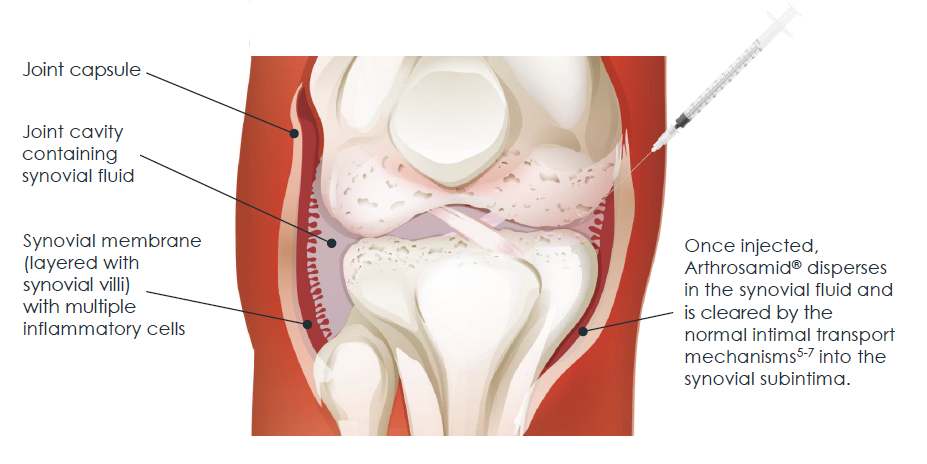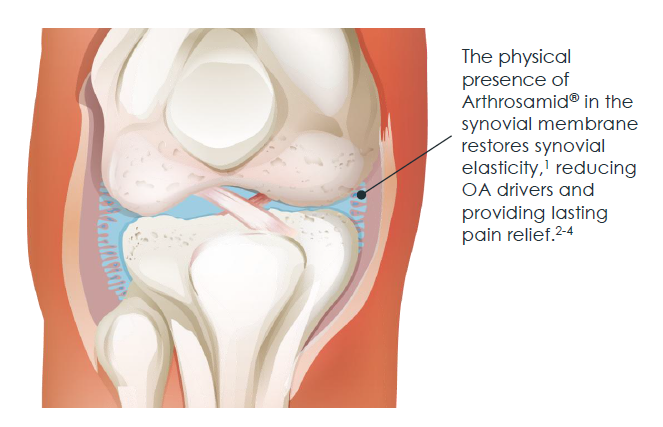

Arthrosamid is an injection that changes the synovial membrane of the joint. It uses polyacrylamide which implants itself within the lining allowing the knee to be less stiff and inflamed.
Compared to cartilage breakdown, synovial inflammation (synovitis) is generally considered to be the more direct and primary source of joint pain.
The articular cartilage is actually aneural, which means that there are no nerve endings here that transmit pain signals. Instead, pain is detected mainly through the synovium and the the surrounding joint capsule, soft tissue, and bone just beneath the cartilage.
In fact, it is well known that even in those with severe, “bone-on-bone” arthritis, there can be no pain if there is no associated inflammation or structural issue.
Polyacrylamide has been studied for more than 20 years and has been used in humans since 2010. It received Health Canada approval in early 2025.
The medical research for this procedure is continually evolving. It does not work for everybody. Please speak with your physician to determine if this is the right treatment for you.


This is a reasonable option as either first-line treatment, or in cases where other injections like cortisone, hyaluronic acid, or PRP have not worked. Polyacrylamide can provide benefit even in severe cases, as it’s focus is not on the cartilage itself, but instead the synovium which drives the inflammatory process. After a single injection, patients begin to experience pain relief within 4-12 weeks.
Polyacrylamide does not degrade and can provide relief up to 5 years.
Repeat injections can be performed indefinitely.
Any patient who may appear to have:
Safety and effectiveness have not been established in patients under 18 years or in pregnant/lactating women
You will be prescribed antibiotics prior to your procedure. Please ensure to take this 1-6 hours prior to the injection. This is to avoid severe infections, as the polyacrylamide is not meant to degrade like other injections.
If you are scheduled to have a surgical or dental procedure in the future, you should tell the treating doctor that you have a permanent hydrogel implant as this may require prophylactic antibiotic therapy.
Common, but not severe
Not common, but potentially severe
No specific reactions have been described.
For most injections, people can drive afterwards. Nonetheless, bringing a driver is always a good idea just in case. We ask all patients to remain in the clinic waiting room for a minimum of 15 minutes afterwards to observe for any adverse reactions.
This depends on the type of sport and intensity, but we generally recommend taking it easy for 2 days as post-injection flares may occur. If steroid was provided, this takes effect after day 2. Overall, please be mindful with anything you do and listen to your body.
Please see our fees and financing or contact us for more information.
SUITE 303
REHABILITATION SERVICES
(Physiotherapy, Massage Therapy, Chiropractic, & more)
SUITE 304
MEDICAL SERVICES
(Specialist consultations, NCS/EMG,
US-Guided Injections, & more)
P: (905) 826 – 4048
F: (905) 826 – 7201
Info@abilityclinic.ca
Referrals@abilityclinic.ca
Mon-Fri: 8 am to 5 pm
Saturday-Sunday: Closed
(Hours and availability may vary)